How do different cameras and devices see at night?
There is a fairly large number of options to see at night. This is either a night vision device, or a thermal imager, or an illuminated night sight, or maybe an electronic multiplication camera with an EMCCD. Unfortunately, not always all cameras and devices are at hand at the same time, and they usually cannot be compared with each other.
Fortunately, we were lucky, and we had such an opportunity. Moreover, lucky that the weather allowed us to recreate the reference conditions for comparative tests. The moon was absent, the sky was clear, and all that was needed was to leave the city, away from artificial light.
So, what we had with us:
')
1.1 EOC - third-generation electron-optical converter. The best of all devices such as EOC, which had to face. It is very difficult to create conditions under which he sees nothing. The resolution of the image intensifier 68lin / mm. The maximum spectral sensitivity should be in the region of 800 nm. The image intensifier is connected to the VC249 camera based on a low-noise sensor. The resolution of the camera is much higher the resolution of the image intensifier, so the camera does not affect the result.
1.2 The VS320 is a near-infrared (SWIR) camera with sensitivity in the range of the spectrum from 0.9 to 1.8 microns. The spectral sensitivity is almost flat. The resolution is 320x256, the size of the photosensitive element is 25x25µm.
1.3 VC400 - “ordinary” camera of visible range on the basis of silicon structure. "Normal" in quotes, because it is a camera for astronometric observations with back light. The resolution is 2000x2000, the size of the photosensitive element is more than 10 microns. Maximum spectral characteristics in the region of 550 nm.
All cameras are designed and manufactured in Russia, but this should not embarrass anyone, since the element base (with the exception of the image intensifier) is quite an import.
Shooting conditions:
1. Date: the night of January 8/9, 2018.
2. The latitude is about 58 degrees, the longitude is about 31 degrees.
3. Moonless starry night.
4. The permeability of the sky to 19st.v. (indirect estimate).
5. Illumination at ground level (more precisely snow): 2.5nW / cm ^ 2 (or some conditional 4 μm).
6. The exposure time of all devices is 40ms, which corresponds to a frame rate of 25 Hz.
Immediately anticipating questions on the field of illumination on the ground, we have already tormented ourselves with photometric values (suites, candela ...), which do not allow us to compare cameras with each other, and therefore we mostly use radiometric or natural (like "starry night", "full moon" ), in this case it is a starry night without a moon.
The scene was formed in the classic way: “night, street, lantern ...” and your humble servant with a table. Actually, since many have already been waiting for pictures, I do not consider it possible to delay.
In turn: here is a frame with an image intensifier:
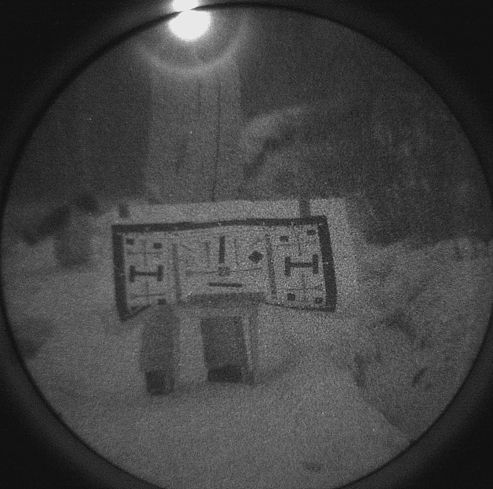
Here is the frame from VS320 (SWIR):

But the VC400 (visible range)

Unfortunately, the field of view angles are different, but it was not possible to pick up all three high-aperture lenses (about one), which would provide the same field of view.
Many will wonder why in the hands of this terrible lantern? In fact, this is not a flashlight, it is a very weak LED wrapped in cloth to provide illumination in all directions, and it is needed to confirm a short exposure time. Lubrication of the flashlight on the frame corresponds to an exposure time of 40ms:

The absence of the moon is confirmed by the absence of shadows from the objects.
And so look larger objects (in order of the EOP, visible, IR)

Of the features that can be seen: the sky in the near IR range (up to 2 microns) is really very bright ...
Also, some may think that VS320 does not see stars in the near-infrared range, but they are out of focus in these frames, if you focus, the stars are quite visible to themselves:
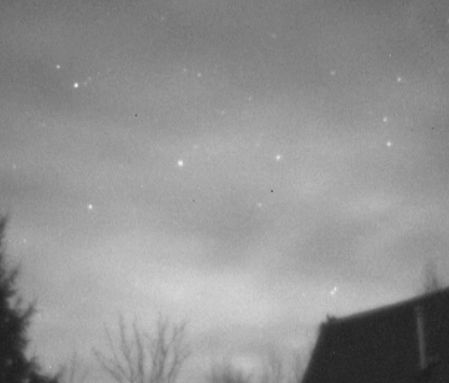
Throughout the video there is another interesting frame:

The VS320 camera in the near IR window glows, but in the visible range is not. Despite the fact that the VS320 camera is not a thermal imager (in the classical sense), its sensitivity is enough to notice the lighting from the cooling down stove in the house.
For those who want to watch videos from all channels at the same time (in full hd format), it is available here .
For readers who tend to consider everything very substantively, there is video in the format of 3000x1000 (non-standard video size), the video is not compressed and is a combination of source code without distortion (registration and SMS): right here .
Separately, video from the camera of the visible range of the VC400 at a frequency of 25 Hz (exposure 40ms) - here .
A small bonus for readers: a test table with different cameras when illuminating the "starry sky". The e2v L3 camera is a benchmark in Europe for its sensitivity. The sensor of the camera has a rectangular pixel of a large area (14x28 µm) and is an EMCCD sensor with electron multiplication, each registered electron in the sensor is amplified 1000 times. Unfortunately, in Russia these cameras (L3) are no longer available (picture from the archive):
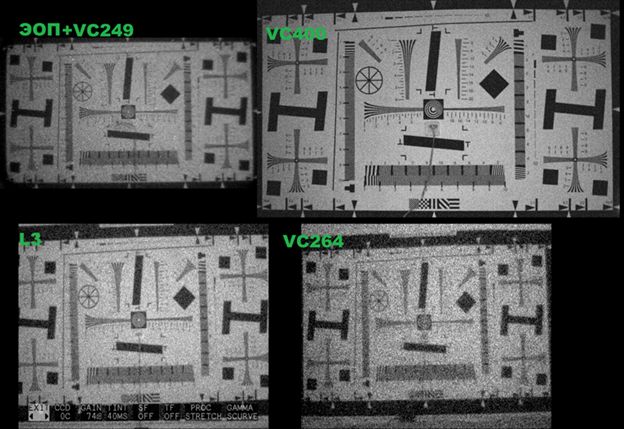
Source image without compression by reference .
It may seem that in all these shots and filming there is nothing unusual, the most low-level cameras. But for example, frames taken on low-level cameras with the same lighting.
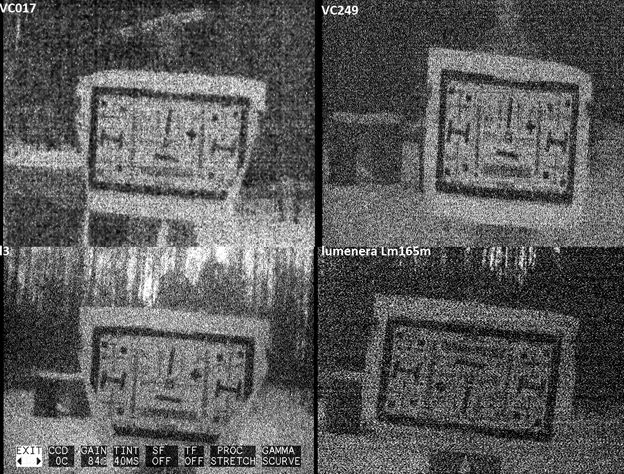
And a link to the video (for sophisticated readers).
Thus, we managed to collect in one place the most sensitive, at the moment, instruments that can be seen sufficiently well at night, and at the same time the instruments operate in close but different spectral ranges.
Well, small conclusions, which probably need to be done. I would not like to impose anything on the readers, since on the whole everything is visible on the presented materials.
Well, in conclusion of this small article, since the camera of the visible range turned out to be astronomical, we could not deny ourselves the pleasure of shooting some beautiful objects (in the “accidentally” Newton telescope turned up (D = 200mm F = 1000mm)):
Orion Nebula:

cloud.mail.ru/public/DWxi/dTFJVY4MJ
and Galaxy M81:
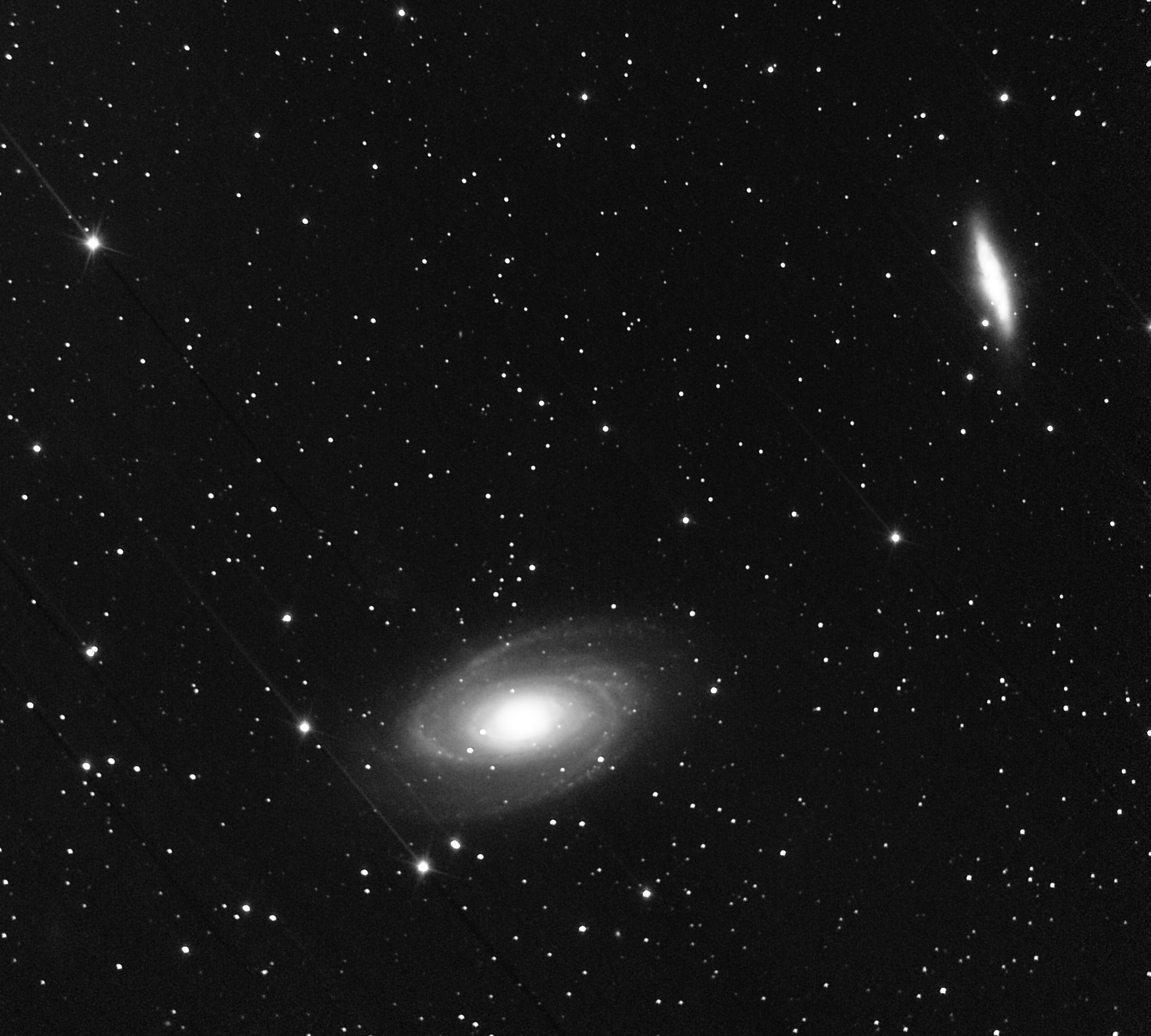
cloud.mail.ru/public/HQPo/YW4oHZeom
On the Internet, there are very few comparative frames and videos, mostly videos of only one camera. Many videos show shadows from the moon, which indicates that the night is far from dark. We hope that this small article will fill this gap, will give some information about how they see certain appliances at night.
Special thanks to those who provided the equipment and cameras, who brought us to the Niva where there is no electricity and artificial lighting, to my colleague with whom we collected all this, removed it and processed it.
ps: when using these materials - a link to the article is required.
Fortunately, we were lucky, and we had such an opportunity. Moreover, lucky that the weather allowed us to recreate the reference conditions for comparative tests. The moon was absent, the sky was clear, and all that was needed was to leave the city, away from artificial light.
So, what we had with us:
')
1.1 EOC - third-generation electron-optical converter. The best of all devices such as EOC, which had to face. It is very difficult to create conditions under which he sees nothing. The resolution of the image intensifier 68lin / mm. The maximum spectral sensitivity should be in the region of 800 nm. The image intensifier is connected to the VC249 camera based on a low-noise sensor. The resolution of the camera is much higher the resolution of the image intensifier, so the camera does not affect the result.
1.2 The VS320 is a near-infrared (SWIR) camera with sensitivity in the range of the spectrum from 0.9 to 1.8 microns. The spectral sensitivity is almost flat. The resolution is 320x256, the size of the photosensitive element is 25x25µm.
1.3 VC400 - “ordinary” camera of visible range on the basis of silicon structure. "Normal" in quotes, because it is a camera for astronometric observations with back light. The resolution is 2000x2000, the size of the photosensitive element is more than 10 microns. Maximum spectral characteristics in the region of 550 nm.
All cameras are designed and manufactured in Russia, but this should not embarrass anyone, since the element base (with the exception of the image intensifier) is quite an import.
Shooting conditions:
1. Date: the night of January 8/9, 2018.
2. The latitude is about 58 degrees, the longitude is about 31 degrees.
3. Moonless starry night.
4. The permeability of the sky to 19st.v. (indirect estimate).
5. Illumination at ground level (more precisely snow): 2.5nW / cm ^ 2 (or some conditional 4 μm).
6. The exposure time of all devices is 40ms, which corresponds to a frame rate of 25 Hz.
Immediately anticipating questions on the field of illumination on the ground, we have already tormented ourselves with photometric values (suites, candela ...), which do not allow us to compare cameras with each other, and therefore we mostly use radiometric or natural (like "starry night", "full moon" ), in this case it is a starry night without a moon.
The scene was formed in the classic way: “night, street, lantern ...” and your humble servant with a table. Actually, since many have already been waiting for pictures, I do not consider it possible to delay.
In turn: here is a frame with an image intensifier:

Here is the frame from VS320 (SWIR):

But the VC400 (visible range)

Unfortunately, the field of view angles are different, but it was not possible to pick up all three high-aperture lenses (about one), which would provide the same field of view.
Many will wonder why in the hands of this terrible lantern? In fact, this is not a flashlight, it is a very weak LED wrapped in cloth to provide illumination in all directions, and it is needed to confirm a short exposure time. Lubrication of the flashlight on the frame corresponds to an exposure time of 40ms:

The absence of the moon is confirmed by the absence of shadows from the objects.
And so look larger objects (in order of the EOP, visible, IR)

Of the features that can be seen: the sky in the near IR range (up to 2 microns) is really very bright ...
Also, some may think that VS320 does not see stars in the near-infrared range, but they are out of focus in these frames, if you focus, the stars are quite visible to themselves:

Throughout the video there is another interesting frame:

The VS320 camera in the near IR window glows, but in the visible range is not. Despite the fact that the VS320 camera is not a thermal imager (in the classical sense), its sensitivity is enough to notice the lighting from the cooling down stove in the house.
For those who want to watch videos from all channels at the same time (in full hd format), it is available here .
For readers who tend to consider everything very substantively, there is video in the format of 3000x1000 (non-standard video size), the video is not compressed and is a combination of source code without distortion (registration and SMS): right here .
Separately, video from the camera of the visible range of the VC400 at a frequency of 25 Hz (exposure 40ms) - here .
A small bonus for readers: a test table with different cameras when illuminating the "starry sky". The e2v L3 camera is a benchmark in Europe for its sensitivity. The sensor of the camera has a rectangular pixel of a large area (14x28 µm) and is an EMCCD sensor with electron multiplication, each registered electron in the sensor is amplified 1000 times. Unfortunately, in Russia these cameras (L3) are no longer available (picture from the archive):

Source image without compression by reference .
It may seem that in all these shots and filming there is nothing unusual, the most low-level cameras. But for example, frames taken on low-level cameras with the same lighting.

And a link to the video (for sophisticated readers).
Thus, we managed to collect in one place the most sensitive, at the moment, instruments that can be seen sufficiently well at night, and at the same time the instruments operate in close but different spectral ranges.
Well, small conclusions, which probably need to be done. I would not like to impose anything on the readers, since on the whole everything is visible on the presented materials.
- In the near IR range (1-2 microns), the sky clearly glows, it is written in various articles about this, but in fact it is very difficult to find a video in free access. We clearly observed a heterogeneous, but stable structure of the glow of the sky, similar in some ways to the northern lights. Thanks to this glow, the VS320 near-infrared camera sees well at night. Unfortunately, the camera instance that we had had a low resolution, but the device showed itself with dignity. Unambiguously, near-infrared cameras can be used to improve visibility.
- EOP of the third generation does an excellent job with its task and sees at night. Unfortunately, the resolution 68lin / mm is not very large, but sufficient to navigate and find objects.
- The discovery is the possibility of silicon CMOS devices of the visible range, on the basis of which the VC400 camera is made, to be compared and even by permission to surpass third-generation night-vision devices.
Well, in conclusion of this small article, since the camera of the visible range turned out to be astronomical, we could not deny ourselves the pleasure of shooting some beautiful objects (in the “accidentally” Newton telescope turned up (D = 200mm F = 1000mm)):
Orion Nebula:

cloud.mail.ru/public/DWxi/dTFJVY4MJ
and Galaxy M81:

cloud.mail.ru/public/HQPo/YW4oHZeom
On the Internet, there are very few comparative frames and videos, mostly videos of only one camera. Many videos show shadows from the moon, which indicates that the night is far from dark. We hope that this small article will fill this gap, will give some information about how they see certain appliances at night.
Special thanks to those who provided the equipment and cameras, who brought us to the Niva where there is no electricity and artificial lighting, to my colleague with whom we collected all this, removed it and processed it.
ps: when using these materials - a link to the article is required.
Source: https://habr.com/ru/post/374163/
All Articles